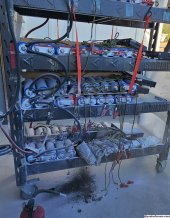Systems Planet
New Member
- Joined
- Jun 25, 2020
- Messages
- 35
My home build LTO battery had a fire last night.
We heard a large pop and came out to find a small arc fire in one of the cells. One of the cells had popped completly apart. The wiring was arcing and causing a small flame.
We were running five 10 amp active balancers on five 22S banks.
Either:
- the balancer died
- a cell went bad, or
- the wiring became corroded and high current.
I post this to remind people that we need a mechanism to detect these events and shut everything off and alert you to the problem.
LTO chemistry is amazing.
This could have been much worse.
Our small arch fire was easily put out with a CO2 fire extinguisher.
The battery cart was on wheels and easily wheeled outside, away from the house, while we dealt with the fire.
When you plan for a fire,
you're ready for a fire.
Make sure your batteries are on wheels, you have a fire extinguisher, and a fire plan to get flaming batteries away from your home.
Be safe.
We heard a large pop and came out to find a small arc fire in one of the cells. One of the cells had popped completly apart. The wiring was arcing and causing a small flame.
We were running five 10 amp active balancers on five 22S banks.
Either:
- the balancer died
- a cell went bad, or
- the wiring became corroded and high current.
I post this to remind people that we need a mechanism to detect these events and shut everything off and alert you to the problem.
LTO chemistry is amazing.
This could have been much worse.
Our small arch fire was easily put out with a CO2 fire extinguisher.
The battery cart was on wheels and easily wheeled outside, away from the house, while we dealt with the fire.
When you plan for a fire,
you're ready for a fire.
Make sure your batteries are on wheels, you have a fire extinguisher, and a fire plan to get flaming batteries away from your home.
Be safe.



